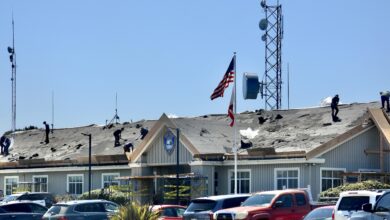Navy grants local requests for extension and explanation of ocean testing plans
Once again, the U.S. Navy has extended the public comment period about a big increase in the use of sonar, underwater explosions and other military training exercises off the Pacific Northwest.
The latest in a series of comment period extensions — to Monday, April 13 — was just what Mendocino County supervisors and Congressman Mike Thompson had asked for.
“I”m pleased that after I met with the Navy, they agreed to extend the public comment period and allow everyone more time to weigh in,” Thompson said.
“The Navy will come to Mendocino [County] and hold a public meeting to hear concerns and answer questions from the community. I”ve asked the Navy and fishing organizations to look more closely at the impact this proposal will have on ocean wildlife and fishing families,” said Thompson, D- St. Helena, whose district includes both Humboldt and Mendocino counties.
The Navy had initially failed to inform members of Congress, the press or local governments in the region where testing will be expanded, which runs from Northern California to Canadian border.
California”s two U.S. senators were unaware of the existence of the environmental impact statement shortly before the first public comment deadline, several news accounts said. An initial extension was granted. A group of eight Oregon Congressmen wrote a letter complaining about poor communication. That effort won the previous extension — to March 11.
With still limited press releases and no direct communication with lawmakers, word continued to spread slowly. Thompson and Mendocino County supervisors complained and asked for yet another extension, accompanied by direct dialogue.
The Navy granted the requests and will extend the deadline for public comment to April 13. Honoring another local request, the Navy plans to send a representative to speak to Mendocino County supervisors, with a date to be announced.
Questions remain.
Although more than 1,000 pages of information are available on a Website created for the Northwest Training Range Complex (NWTRC), many details are hard to find and there is no phone number or email for the public to ask questions.
This reporter could find no southern boundary stated in the 1,000-plus pages of the environmental impact statement. A map included in the plan shows the southern boundary to be somewhere just south of Shelter Cove, which is the Humboldt-Mendocino county line.
Another question is how increased medium range sonar use might affect marine mammals and sealife.
There will also be increased air and land testing by the Navy. Other branches of the service can also use the area. The inland area is comprised of most of the state of Washington.
There are several options in the documents available for public comment, including a no-action alternative and two options that feature increased testing of new aircraft, missiles, underwater explosives and sonar.
While the military has been training in the area since before World War I, the environmental impact statement concludes that increased use of new weapons to the area could have impacts on birds, whales, fish and the ocean environment.
Unmanned aerial and ocean systems, new surface to air missiles, and a big increase in use of sonobuoys would all be part of the increased activity. The Navy would deploy 9,651 of the sonar emitting sonobuoys each year under their preferred plan.
Also to be tried out under the Navy”s preferred alternative would be unmanned or “drone” aircraft, development of a training minefield fixed to the ocean bottom and development of a portable undersea tracking range.
The environmental impact statement offers one of the most comprehensive and detailed documents about the Pacific Northwest ocean and its creatures. The report is found at www.nwtrangecomplexeis.com
The Website contains an audio and movie presentation that explains why the training is needed by all branches of the service and how the Navy seeks to be a good steward of the environment.
“Realistic training is the most crucial asset available for training members of the Armed Services,” the audio says.
The most intensive activities are in special designated areas off Oregon and Washington.
Until April 13, the public can provide comments on the draft EIS as part of the “scoping process.” Next, a final environmental statement will be released for public review that responds to all those public comments.
“Finally, a Record of Decision (ROD) will summarize the Navy”s decision and describe the public involvement and agency decision-making processes, and include commitments to specific mitigation measures,” the environmental impact statement says.
At the same time as the Navy is increasing its activity off the Pacific Northwest, an even more ambitious effort is under way in the Gulf of Mexico. There the Navy has proposed testing fighting submarines and airplanes offshore from Texas to Florida. Objections about the impact on whales have been raised there, but that process has apparently not been fraught with communication gaffes.
That also newly-minted environmental impact statement can be seen at www.gomexrangecomplexeis.com.
Electronic comments on the Pacific plan can be submitted using a form on the website. Mailed commenters are asked to use the same form, which can be downloaded and printed and sent to: Naval Facilities Engineering Command Northwest, 1101 Tautog Circle, Suite 203, Silverdale, WA 98315-1101, ATTN: Mrs. Kimberly Kler – NWTRC EIS.




